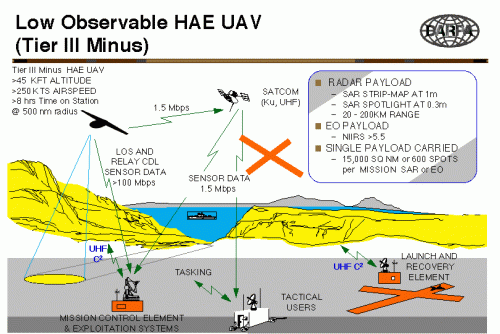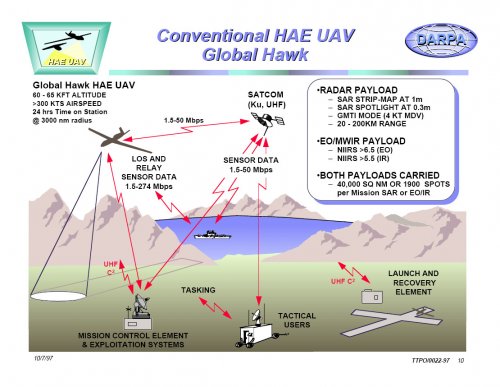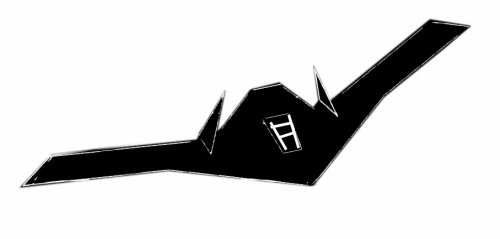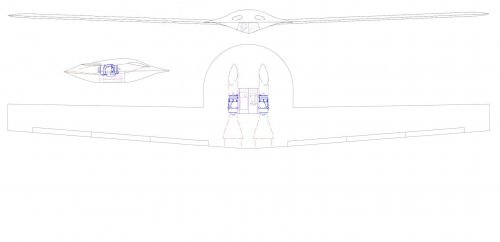CFE said:
In 2003, AWST was reporting unverified claims that a Darkstar follow-on was used in the opening phase of OIF. Since then, there's been no info to corroborate the claim.
A Classified Lockheed Martin Unmanned Reconnaissance Aircraft Was Used in Iraq
Jul 6, 2003
By David A. Fulghum
STEALTH UAV GOES TO WAR
Not a lot has been written about new products from Lockheed Martin's Skunk Works during the last couple of years, but aerospace officials say the advanced projects company has produced prototypes of a classified, unmanned aerial vehicle--built strictly as an intelligence-gathering aircraft--that "has been used" operationally over Iraq.
The aircraft is described by a U.S. Air Force official as a derivative of the "DarkStar" (Tier 3-minus) program that was canceled after the demonstration aircraft was test flown and then declared operationally unsuitable. The new Lockheed Martin UAV is "highly reliable," in part because of a much improved flight control system, the Air Force official said. "It's the same concept as DarkStar, it's stealthy, and it uses the same apertures and data links," he said. "The numbers are limited. There are a couple of airframes, a ground station and spare parts."
The classified UAV's operation caused consternation among USAF U-2 pilots who noticed high-flying aircraft operating within several miles of their routes over Iraq, a distance they considered too close for comfort. The mysterious aircrafts' flights were not coordinated with those of the other manned and unmanned surveillance aircraft, they said.
"It has the hull form of the DarkStar, only it's bigger," agreed a U.S. Navy official. "It's still far from a production aircraft, but the Air Force wanted to go ahead and get it out there. They have to determine if the intelligence they can gather from it is worth paying several times more than the cost of the [non-stealthy] Global Hawk."
Lockheed Martin conceded the non-stealthy UAV role to Northrop Grumman's Global Hawk, but company officials then committed themselves to a full court press to ensure they had a significant share of the Pentagon's stealthy UAV market.
FOR THE LAST DECADE, the Air Force and studies by Rand and other research organizations have expressed unwavering support of the need for a penetrating low-observable UAV, so the existence of the program comes as no surprise to other aerospace officials. The only surprise is that an early version of the aircraft has seen operational use so quickly.
A second Air Force official who once had oversight of UAV and unmanned combat air vehicle (UCAV) programs also described the Lockheed Martin UAV as a "DarkStar-like thing." The problems that loomed large in the project were flight controls, command and control and stealthy apertures--in particular low probability of intercept (LPI) communications antennas, he said. The aircraft is given new tasks, and intelligence is downloaded through satellite links. Therefore, the antennas have to be on top of the aircraft to shield them from electronic surveillance. Infrared signature reduction was also in the design.
The Lockheed Martin aircraft that has been used operationally is a non-production version of the design with more limited performance, particularly in altitude, an aerospace official said. The second Air Force official agreed that "getting the [new designs] out there and using them is the right thing to do," to help introduce the capability.
Boeing also has a classified UAV that serves as a testbed for designing and testing new stealth capabilities, the second Air Force official said. The conventional takeoff and landing UAV is a modular design that allows company researchers to fly it in various shapes and configurations. For example, different wings, tails and noses have been tested on the aircraft. In fact, he contends that Boeing has had a more aggressive program of investments in advanced stealth technology over the last several years than Lockheed Martin.
Those familiar with the Lockheed Martin program often describe it by what it is not. It is smaller and carries a "less robust" payload than the U-2. Its size is said to be a deliberate calculation by Lockheed Martin and the Air Force to avoid threatening the manned U2 program. Other Air Force officials said there is no conflict because the U2 is getting old, becoming expensive to operate and the program has had a problem with retaining enough pilots trained to keep up with operational demands. "Unless they build new U-2s, the aircraft aren't sustainable over the long haul," the second Air Force official said.
The UAV also lacks the endurance of the Predator or Global Hawk UAVs. Nonetheless, the aircraft's ability to "dwell" over a target area for several hours is highly valued. Its surveillance package options include an LPI synthetic aperture radar salvaged from the Navy's A-12 program as well as infrared and electro-optical sensors (AW&ST June 4, 2001, p. 30). The Air Force has had a long-standing requirement for a very-low-observable, high-altitude UAV that can fly 1,000 naut. mi. to a target, penetrate modern air defenses such as the SA-10, SA-12 and SA-20 anti-aircraft missile systems, loiter for at least 8 hr. and return to base.
Those familiar with operational concepts for aircraft that need to be kept out of sight suggested that Al Udeid AB, Qatar, with its lengthened runways and new drive-through hardened hangars--which were off-limits to reporters during this year's conflict with Iraq--would have offered an ideal base for the UAVs. Its proximity to Iraq would have permitted maximum surveillance time over the well-defended areas around Baghdad in the pre-war period. Visual sightings would have been avoided by restricting operations to the hours between 9 p.m. and 4 a.m.
The Defense Dept. plans to spend $23.3 billion in Fiscal 2004 ($11.3 billion on weapons procurement and $11.8 billion for research and development), according to a new report by the Center for Strategic and Budgetary Assessments. Classified acquisition funding has increased by about 75% since Fiscal 1995, the report said. It also noted that the Air Force's budget request contains 75% of the Defense Dept.'s classified acquisition funding and that classified programs account for 37% ($10.9 billion) of the service's procurement request and 32% ($6.6 billion) of its research and development requests. The budget is inflated each year by Air Force spending on behalf of the CIA, National Security Agency (NSA) and National Reconnaissance Office.
NSA, for example, has responsibility for intercepting and decoding foreign messages. But the proliferation of cell phone technology has overwhelmed the ability of the nation's signals intelligence-gathering satellites to collect and analyze much of this data. The answer may be communications intelligence payloads fitted to UAVs. The unmanned aircraft offer a more flexible schedule than satellites, can observe operations far longer and are cheaper, said UAV advocates.
The U.S. flew Ryan-built "Combat Dawn" UAVs into North Korea, China and North Vietnam in the 1970s. Later, at least three "black" UAV programs--Advanced Airborne Reconnaissance System ($500 million each), "Quartz" ($200 million) and Tier-3 ($150 million)--were planned and then canceled for high costs.
In addition to the intelligence-gathering UAV that Lockheed Martin developed using its own money, the Skunk Works also has been developing a classified UCAV demonstration program at least since 2000 with the idea of competing against Boeing's X-45 and Northrop Grumman's X-47 UCAV demonstrators (AW&ST Sept. 25, 2000, p. 28). Now Northrop Grumman, as the prime contractor, and Lockheed Martin have announced last week that they will collaborate on UCAV projects under the newly established Defense Advanced Research Projects Agency-led joint program office.
http://www.aviationweek.com/aw/generic/story_generic.jsp?channel=awst&id=news/07073news.xml





